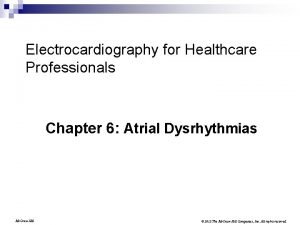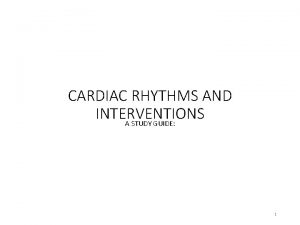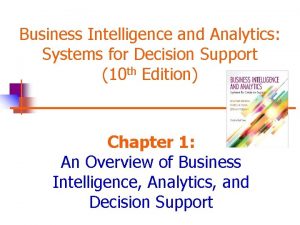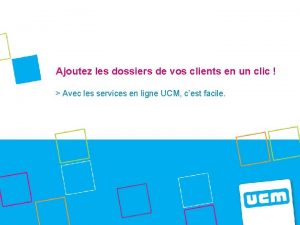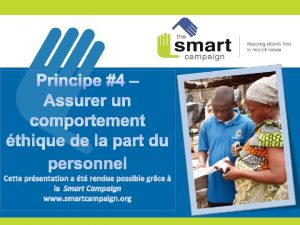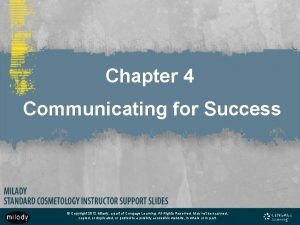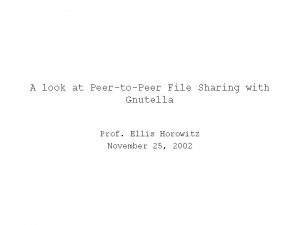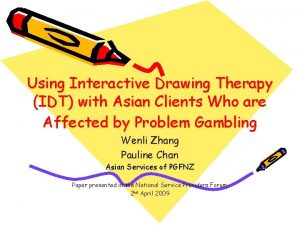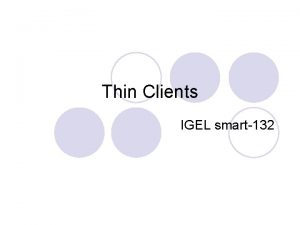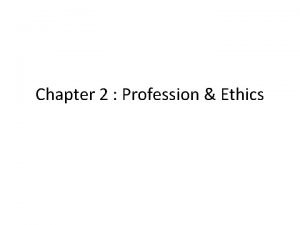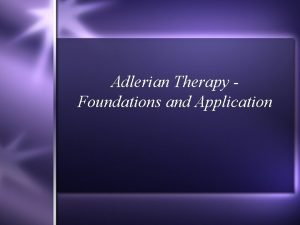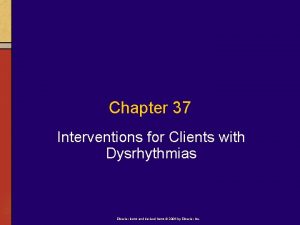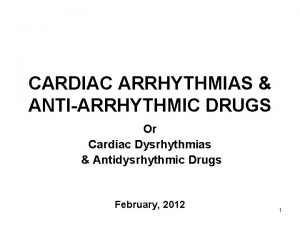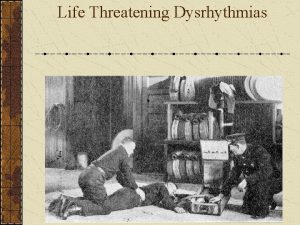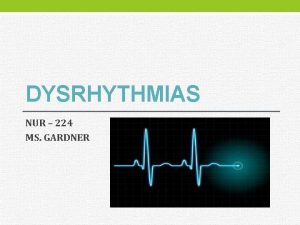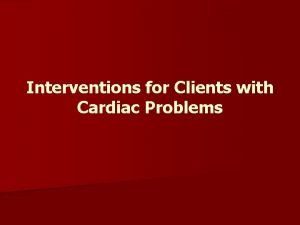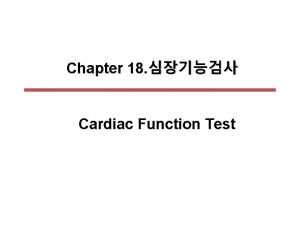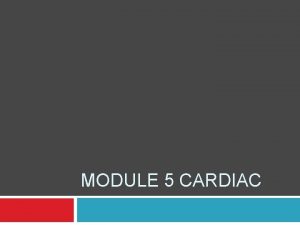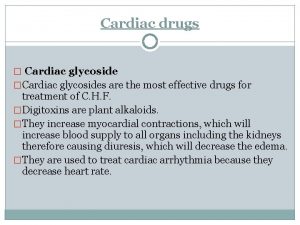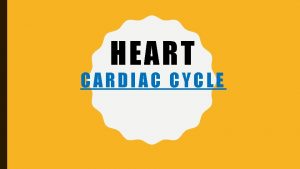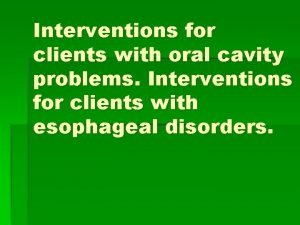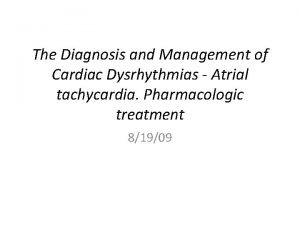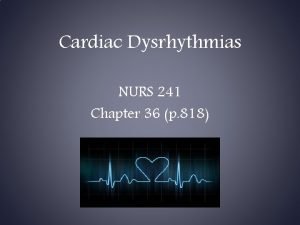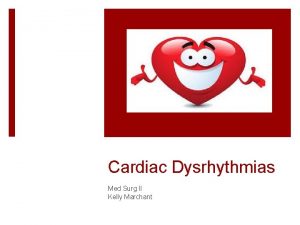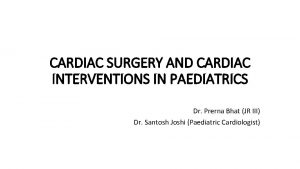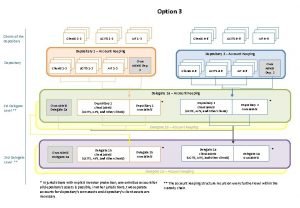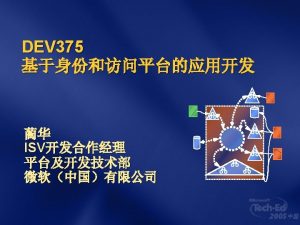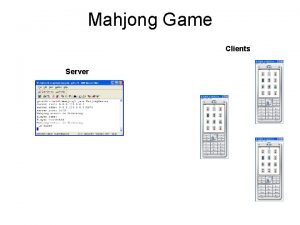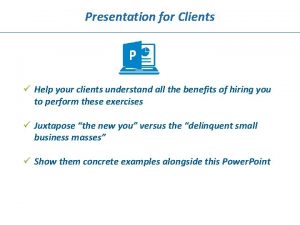Interventions for Clients with Dysrhythmias n Cardiac dysrhythmias
















































































- Slides: 80

Interventions for Clients with Dysrhythmias

n Cardiac dysrhythmias are disturbances of cardiac electrical impulse formation, conduction, or both

Review of Cardiac Electrophysiology Automaticity (spontaneous depolarization) is the ability of cardiac cells to generate an electrical impulse spontaneously and repetitively. Normally, only primary pacemaker cells possess this property. Under certain conditions, such as myocardial ischemia (decreased blood flow) and infarction (cell death), any cardiac cell may exhibit this property, generating electrical impulses independently and creating dysrhythmias n Excitability is the ability of nonpacemaker cardiac cells to respond to an electrical impulse generated from pacemaker cells and to depolarize. Depolarization occurs when the normally negatively charged cells develop a positive charge n Conductivity is the ability to transmit an electrical stimulus from cell membrane to cell membrane. Consequently, ex citable cells depolarize in rapid succession from cell to cell until all cells have depolarized. This wave of depolarization gives rise to the deflections of the electrocardiogram (ECG) waveforms that are recognized as the P wave and the QRS complex n

Review of Cardiac Electrophysiology Contractility is the ability of atrial and ventricular muscle cells to shorten their fiber length in response to electrical stimulation, generating sufficient pressure to propel blood forward. This is the mechanical activity of the heart n Action potential – The cardiac cell membrane (sarcolemma) exhibits selective permeability to ions. An ion is an electrically charged particle. This creates an electrical imbalance, known as an action po tential, across the cell membrane. The cardiac cell at rest has an internal negative charge, whereas the charge outside the cell is positive. This state of electrical imbalance of the resting cell is called resting membrane potential n

Cardiac Conduction System n Sinoatrial node – Electrical impulses at 60 to 100 beats/min n Atrioventricular junctional area n Bundle branch system


Electrocardiography n Electrocardiogram (ECG) provides a graphic represen tation, or picture, of cardiac activity A lead provides one view of the heart's electrical activity. Multiple leads, or views, can be obtained. Electrode placement is the same for male and female clients. n Lead systems are made up of a positive pole and a negative pole. An imaginary line joining these two poles is called the lead axis. n The direction of electrical current flow in the heart is the n cardiac axis. n The relationship between the cardiac axis and the lead axis is responsible for the deflections seen on the ECG pattern

Electrocardiography n n n n Limb leads Standard bipolar limb leads consist of three leads that each measure the electrical activity between two points, and a fourth lead (right leg) that acts solely as a ground electrode. Of the three measuring leads, the right arm is always negative, the left leg is always positive, and the left arm can be either positive or negative. Bipolar leads can be obtained by using a monitor with either three or five electrode cables or a 12 lead ECG machine. Leads I, II, and III are bipolar leads. Unipolar limb leads consist of a positive electrode only. These leads can be obtained only by using a monitor with four or five electrode cables or a 12 lead ECG machine. The unipolar limb leads are a. VR, a. VL, and a. VF, with a meaning augmented. V is a designation for a unipolar lead. The third letter denotes the positive electrode placement: R for right arm, L for left arm, and F for foot (left leg). The positive electrode is at one end of the lead axis. The other end is the center of the electrical field, at approximately the center of the heart

Electrocardiography n n n Chest leads Chest (precordial) leads are also unipolar, or V, leads and therefore can be obtained only from a monitor with five electrode cables or a 12 lead ECG machine, which usually has 10 electrode cables. There are six chest leads, determined by the placement of the chest electrode. The four limb electrodes are placed on the extremities, as designated on each electrode (right arm, left arm, right leg, and left leg). The fifth (chest) electrode on a monitor system is the positive, or exploring, electrode and is placed in one of six designated positions to obtain the desired chest lead. With a 12 lead ECG, four leads are placed on the limbs and six are placed on the chest, eliminating the need to move any electrodes about the chest

Electrocardiography n n Continuous electrocardiographic monitoring For continuous electrocardiographic (ECG) monitoring, the electrodes are not placed on the limbs, because movement of the extremities causes "noise, " or motion artifact, on the ECG signal. The nurse places the electrodes on the trunk, a more stable area, to minimize such artifacts and to obtain a clearer signal. The nurse places the electrodes as follows: – Right arm electrode just below the right clavicle – Left arm electrode just below the left clavicle – Right leg electrode on the lowest palpable rib, on the right midclavicular line – Left leg electrode on the lowest palpable rib, on the left midclavicular line – Fifth electrode placed to obtain one of the six chest leads n With this placement, the monitor lead select control may be changed to provide lead I, III, a. VR, a. VL, or a. VF or one chest lead. The monitor automatically alters the polarity of the electrodes to provide the lead selected

Electrocardiography n n Telemetry ECG cables may be attached directly to a wall mounted monitor (a hard wired system) if the client's activity is restricted to bedrest and sitting in a chair, as in a critical care unit. For an ambulatory client, the ECG cable is attached to a battery operated transmitter (a telemetry system) held in a pouch worn by the client. The ECG is transmitted via antennae located in strategic places, usually in the ceiling, to a remote monitor. This device allows freedom of movement within a certain radius without losing transmission of the ECG




Electrocardiographic Complexes, Segments, and Intervals n n n n n P wave PR segment PR interval it normally measures from 0. 12 to 0. 20 second QRS complex QRS duration it normally measures from 0. 04 to 0. 10 second ST segment it is normally not elevated more than 1 mm or depressed more than 0. 5 mm from the isoelectric line. Its amplitude is measured at a point 1. 5 to 2 mm after the J point T wave U wave QT interval


Electrocardiographic Rhythm Analysis

Normal Rhythms n Normal sinus rhythm is the rhythm originating from the sinoatrial (SA) node (dominant pacemaker) that meets the following electrocardiographic (ECG) criteria: – Rhythm: Atrial and ventricular rhythms regular – Rate: Atrial and ventricular rates of 60 to 100 beats/min – P waves: Present, consistent configuration, one P wave before each QRS complex – PR interval: 0. 12 to 0. 20 second and constant – QRS duration: 0. 04 to 0. 10 second and constant


Normal Rhythms n n Sinus arrhythmia is a variant of NSR. It results from changes in intrathoracic pressure during breathing. In this context the term arrhythmia does not denote an absence of rhythm, as the term suggests. Instead, the heart rate increases slightly during inspiration and decreases slightly during exhalation

Dysrhythmias Tachydysrhythmias are heart rates greater than 100 beats/min n Bradydysrhythmias are characterized by a heart rate less than 60 beats/min n Premature complexes are early complexes. They occur when a cardiac cell or cell group, other than the sinoatrial (SA) node, becomes irritable and fires an impulse before the next sinus impulse is generated. This abnormal focus is called an ectopic focus and may be generated by atrial, junctional, or ventricular tissue n

Dysrhythmias n Repetitive rhythms premature complexes may occur repetitively in a rhythmic fashion – bigeminy exists when normal complexes and premature complexes occur alternately in a repetitive two beat pattern, with a pause occurring after each premature complex so that complexes occur in pairs. – trigeminy is a repetitive three beat pattern, usually occurring as two sequential normal complexes followed by premature complex and a pause, with the same pattern repeating itself in triplets. – quadrigeminy is a repetitive four beat pattern, usually occurring as three sequential normal complexes fol lowed by a premature complex and a pause, with the same pattern repeating itself in a four beat pattern n Escape complexes and rhythms occur when the SA node fails to discharge or is blocked or when a sinus impulse fails to depolarize the ventricles because of an atrioventricular (AV) nodal block

Sinus tachycardia When the rate of SA node discharge exceeds 100 beats/min n Clinical manifestations the client may be asymptomatic except for the in creased pulse rate. However, if the rhythm is not well tolerated, he or she may become symptomatic. The client is assessed for fatigue, weakness, shortness of breath, orthopnea, neck vein distention, decreased oxygen saturation, and decreased blood pressure. The nurse also assesses for restlessness and anxiety from decreased cerebral perfusion and for decreased urine output from decreased renal perfusion. The adult client may experience anginal pain. The electrocardiographic (ECG) pattern may show T wave inversion or ST segment elevation or depression in response to myocardial ischemia n

Sinus tachycardia (heart rate, 110 beats/min; PR interval, 0. 12 second; QRS complex, 0. 08 second)

Sinus tachycardia n n n n Interventions The goal is to decrease the heart rate to normal levels by treating the underlying cause. For example, if the client has angina, the nurse administers oxygen, helps the client to rest, and administers nitroglycerin or morphine as prescribed. Diuretics and inotropic agents may be given for heart failure. The nurse initiates intravascular volume replacement for hypovolemia, administers antipyretics and antibiotics to the client with fever and infection, or provides comfort measures and administers analgesics or opioids to the client with noncardiac pain, as ordered. The nurse collaborates with the respiratory therapist when indicated to oxygenate and suction the client with hypoxemia from excessive airway secretions. Beta adrenergic blocking agents may be prescribed for the client with inappropriate sympathetic nervous system stimulation. Emotional support and relevant teaching are important for the client and family

Sinus Bradycardia Rate of sinus node discharge < 60 beats/min n Clinical manifestations - the client may be asymptomatic, except for the decreased pulse rate. However, at times the rhythm may not be well tolerated. The nurse assesses the client for dizziness, weakness, syncope, confusion, hypotension, diaphoresis, shortness of breath, ventricular ectopy, and anginal pain n

Sinus bradycardia (heart rate, 52 beats/min; PR interval, 0. 18 sec ond; QRS complex, 0. 08 second)

Sinus Bradycardia Interventions If the client is symptomatic and the underlying cause cannot be determined, the treatment of choice is atropine administration, given as prescribed to increase the heart rate to approximately 60 beats/min. n Oxygen should be applied. If the heart rate does not increase sufficiently, the nurse may apply an external pacemaker to increase the heart rate and notify the physician. n However, if atropine administration succeeds in achieving an adequate heart rate but the client remains hypotensive, the nurse initiates intravascular volume replacement, as ordered, rather than administering another dose of atropine. Excessive atropine may induce tachycardia n n

Premature Atrial Complexes Ectopic focus of atrial tissue fires an impulse before the next sinus impulse is due. n Clinical manifestations the client is usually asymptomatic, except for possible heart palpitations, because PACs usually have no hemodynamic consequences n Interventions no intervention is usually needed except to treat the cause, such as heart failure or valvular disease. The nurse administers prescribed type antidysrhythmics, such as quinidine and procainamide (Pronestyl), or other drugs such as digitalis and propranolol (Inderal, Apo Propranolol). Measures to reduce stress are also initiated, and the client is taught to avoid substances known to increase atrial irritability n

Normal sinus rhythm with a premature atrial complex (PAC) at arrow

Supraventricular Tachycardia n Rapid stimulation of atrial tissue occurs at a rate of 100 to 280 beat/min with a mean of 170 beats/min in adults. n Paroxysmal supraventricular tachycardia rhythm is intermittent and terminated suddenly with or without intervention.

Sustained supraventricular tachycardia in a client with Wolff Parkinson White syndrome. Heart rate is 200 beats/min

Supraventricular Tachycardia n Clinical manifestations the clinical manifestations depend on the duration of the SVT and the rate of the ventricular response. In clients with a sustained rapid ventricular response, the nurse assesses for palpitations, weakness, fatigue, shortness of breath, nervousness, anxiety, hypotension, and syncope. Hemodynamic deterioration may occur in the client with cardiac disease, causing angina, heart failure, and shock. With a nonsustained or slower ventricular response, the client may be asymptomatic except for transient palpitations

Supraventricular Tachycardia n n n Interventions If SVT occurs in a healthy person and terminates spontaneously, no intervention is necessary other than eliminating identified causative factors. If it is recurrent, the client should be studied in the electrophysiology laboratory. The preferred treatment for recurrent SVT is radiofrequency catheter ablation. In sustained SVT with a rapid ventricular response, the goals of treatment are to decrease the ventricular response, convert the dysrhythmia to a sinus rhythm, and treat the cause. Vagal stimulation (e. g. , carotid massage) may be successful, but often only transiently, and must be performed only by a physician. The nurse administers oxygen and prescribed antidysrhythmic drugs, which slow the ventricular rate by increasing the AV block. In the severely compromised client, the nurse may assist the physician in attempting atrial overdrive pacing or in delivering a synchronized electrical shock (cardioversion) to reestablish an organized rhythm and regain cardiac stability

Atrial Flutter Rapid atrial depolarization occurring at a rate of 250 to 350 times per minute n Clinical manifestations the clinical manifestations depend on the rate of ventricular response. The nurse assesses the client for palpitations, weakness, fatigue, shortness of breath, nervousness, anxiety, syncope, angina, and evidence of heart failure and shock. Carotid sinus massage transiently decreases the ventricular rate to facilitate rhythm interpretation but can be performed only by the physician. The client with a normal ventricular rate is usually asymptomatic n

Atrial flutter (F) with 4: 1 block. The atrial rate is 280 beats/min; the ventricular rate is 70 beats/min Atrial flutter with 4: 1 conduction, then an 11 beat run with 2: 1 conduction

Atrial Flutter Interventions The treatment goals are the same as those for supraventricular tachycardia (SVT). The nurse administers oxygen and prescribed drugs such as ibutilide (Covert), amiodarone (Cordarone), diltiazem (Cardizem), and verapamil (Calan, Isoptin) to slow the rapid ventricular response. n Quinidine or procainamide (Pronestyl) must not be administered unless one of the above agents has slowed the ventricular response. Both drugs slow the atrial rate and may increase AV conduction, which could cause a 1: 1 conduction with an increase in ventricular rate and hemodynamic deterioration. n The nurse helps the physician to attempt rapid atrial overdrive pacing or to achieve cardioversion if the client is hemodynamically compromised. If he or she fails to respond to these therapies, radiofrequency catheter ablation may be necessary n n

Atrial Fibrillation n Multiple, rapid impulses from many atrial foci at a rate of 350 to 600 times per minute

Atrial Fibrillation n n n Clinical manifestations The nurse assesses the client for the presence of a pulse deficit, fatigue, weakness, shortness of breath, distended neck veins, dizziness, decreased exercise tolerance, anxiety, syncope, palpitations, chest discomfort or pain, and hypotension. The client is also at risk for pulmonary embolism. The nurse should assess for shortness of breath, chest pain, hemoptysis, and a feeling of impending doom. The client is at risk for systemic emboli, particularly an embolic stroke. Changes in mentation, speech, sensory function, and motor function are particularly noted. The nurse also assesses pulses, urine output, back pain, and complaints of gastrointestinal (GI) disturbances. Any of these symptoms should be reported to the health care provider immediately.

Atrial Fibrillation n Interventions Treatment is the same as for atrial flutter. In addition, the nurse may administer anticoagulants, such as heparin, enoxaparin (Lovenox), and sodium warfarin, as prescribed by the physician for clients considered to be at high risk for emboli. Before elective cardioversion, the nurse must initiate anticoagulation therapy for 4 to 5 weeks as prescribed to prevent a thromboembolic event if the rhythm is successfully converted

Junctional Dysrhythmias n Atrioventricular cells generating electrical impulses at a rate of 40 to 60 beats/min n These rhythms are most commonly transient, and clients usually remain hemodynamically stable.

Idioventricular Rhythm Also called ventricular escape rhythm: ventricular nodal cells pace the ventricles. P waves are independent of the QRS complex (AV dissociation). n Clinical manifestations because idioventricular pacemakers are unstable, unreliable, and slow, the client is hypotensive and in shock or, most typically, is pulseless and therefore in cardiac arrest. The nurse assesses the client's airway, breathing, circulation, level of consciousness, and pupillary response n Interventions usually, idioventricular rhythms require immediate resuscitation measures, unless there is a do not resuscitate (DNR) order. The nurse initiates cardiopulmonary resuscitation (CPR) and summons assistance. The team may initiate advanced cardiac life support (ACLS) measures, including epinephrine administration, intravascular volume replacement, and other measures. The physician may attempt pacemaker therapy or discontinue resuscitation efforts n

Idioventricular rhythm with a rate of 35 beats/min

Premature Ventricular Complexes n. A result of increased irritability of ventricular cells: early ventricular complexes followed by a pause

Ventricular dysrhythmias. A, Normal sinus rhythm with unifocal premature ventricular complexes (PVCs). B, Normal sinus rhythm with multifocal PVCs (one negative and the other positive). C, Normal sinus rhythm with three consecutive PVCs (nonsustained ventricular tachycardia) and another unifocal PVC

Premature Ventricular Complexes n n Clinical manifestations The client may be asymptomatic or may experience palpitations or chest discomfort caused by increased stroke volume of the normal beat after the pause. Peripheral pulses may be diminished or absent with the PVCs themselves because the decreased stroke volume of the premature beats may decrease peripheral perfusion. Since other rhythms also cause widened QRS complexes, it is essential that the nurse assess whether the premature complexes perfuse. This is done by palpating the carotid, brachial, or femoral arteries while observing the monitor for widened complexes, or auscultating for the apical heart sounds. With acute myocardial infarction, PVCs may be considered warning dysrhythmias, possibly heralding the onset of ventricular tachycardia (VT) or ventricular fibrillation (VF). For a client with chest discomfort or pain, the nurse reports to the physician whether PVCs increase in frequency, are multiform, are R on T phenomena, or occur in runs of VT

Premature Ventricular Complexes n n n Interventions If there is no underlying heart disease, PVCs are not usually treated other than by eliminating any contributing cause (e. g. , caffeine, stress). With acute myocardial ischemia or infarction, the nurse treats significant PVCs by administering oxygen and lidocaine as prescribed. The nurse may administer other drugs as ordered, including procainamide (Pronestyl), bretylium (Bretylol, Bretylate), magnesium sulfate, propranolol (Inderal, Apo-Propranolol), quinidine, and mexiletine (Mexitil). Potassium is administered as ordered for replacement therapy if hypokalemia is the cause

Ventricular Tachycardia Also called V tach: repetitive firing of an irritable ventricular ectopic focus, usually at a rate of 140 to 180 beats/min n Clinical manifestations n Slower rates are better tolerated. Clients may be hemodynamically compromised if the cardiac output decreases because of the shortened ventricular filling time and loss of the atrial kick. In some clients, VT causes cardiac arrest. The nurse assesses the client's airway, breathing, circulation, level of consciousness, and pupillary response n

Ventricular dysrhythmias. Sustained ventricular tachycardia at a rate of 166 beats/min

Ventricular Tachycardia Interventions For the stable client with sustained VT, the nurse administers oxygen and confirms the rhythm via a 12 lead electrocardiogram (ECG). Amiodarone, procainamide, or magnesium sulfate may be given. n The physician may prescribe an oral antidysrhythmic agent, such as procainamide (Procan SR), mexiletine (Mexitil), or sotalol (Betapace, Sotacor). n For the client with unstable VT, the nurse assists the physician in attempting emergency cardioversion followed by oxygen and antidysrhythmic therapy. The nurse may instruct the client to perform cough cardiopulmonary resuscitation (CPR) if prescribed, telling him or her to inhale deeply and cough hard every 1 to 3 seconds. The physician may attempt rapid atrial or ventricular overdrive pacing if the VT is related to a significant bradydysrhythmia. n A precordial thump is sometimes successful in terminating VT, at least transiently. The physician or the nurse may administer a precordial thump to a client with unstable VT only if a defibrillator and pacemaker are immediately available. n n

Ventricular Tachycardia n n n With pulseless VT, the physician or nurse or other health care provider must immediately defibrillate the client or initiate CPR and defibrillate as soon as possible. A precordial thump may be administered initially, although it is frequently not successful in terminating VT. If the client remains pulseless, the nurse or other health care provider must resume CPR and full resuscitative measures following defibrillation. This includes airway management and administration of oxygen, epinephrine, and antidysrhythmic therapy with amiodarone, magnesium sulfate, and procainamide. If the rhythm has been successfully converted, attention is given to treating reversible causes of VT, such as myocardial ischemia, hypokalemia, and hypomagnesemia. The nurse ensures that oxygen therapy and antidysrhythmic agent administration are continued, and the client is closely monitored for premature ventricular complexes (PVCs) and the recurrence of VT. Some forms of VT may require surgical intervention, such as coronary artery bypass graft (CABG) surgery, implantation of a cardioverter/defibrillator, aneurysmectomy, encircling endocardial ventriculotomy, cryosurgery, or endocardial resection

Ventricular Fibrillation Also called V fib: a result of electrical chaos in the ventricles n Clinical manifestations n On initiation of VF, the client becomes faint, immediately loses consciousness, and becomes pulseless and apneic. There is no blood pressure, and heart sounds are absent. Respiratory and metabolic acidosis develop. Seizures may occur. Within minutes, the pupils become fixed and dilated, and the skin becomes cold and mottled. Death ensues without prompt restoration of an organized rhythm and cardiac output n


Ventricular Fibrillation Interventions The goals of treatment are to terminate VF promptly and convert it to an organized rhythm. The physician or the ACLS nurse or other health care provider must immediately defibrillate the client to accomplish this goal. This is the management priority, and the ACLS algorithm for VF must be followed. If a defibrillator is not readily available, a precordial thump may be delivered. CPR must be continued until the defibrillator arrives. n If the VF does not terminate after three rapid successive shocks of increasing energy, the nurse and resuscitation team resume CPR and provide airway management. They also administer oxygen and antidysrhythmic therapy with epinephrine, amiodarone, procainamide (Pronestyl), lidocaine, and magnesium sulfate, along with attempting defibrillation frequently. n If VF is successfully converted to an organized rhythm, the nurse continues supportive therapy and assists the physician in treating potential causes of VF and preventing its recurrence. n n

Ventricular Asystole n n n Also called ventricular standstill: complete absence of any ventricular rhythm Clinical manifestations Clients are in full cardiac arrest with loss of consciousness and absence of pulse, respirations, and blood pressure. Ventricular asystole is often unresponsive to resuscitation measures and fatal

Ventricular asystole with one idioventricular complex

Ventricular Asystole n n n n Interventions The goal of treatment is to restore cardiac electrical activity. The nurse or other health care provider initiates CPR immediately and summons assistance. Another ECG lead is assessed to ensure that the rhythm is asystole and not fine VF, which warrants immediate defibrillation. When in doubt, the client should be defibrillated. The nurse and resuscitation team manage the airway and administer oxygen, epinephrine, and atropine. The nurse assists the physician with the initiation of noninvasive pacing or invasive transvenous or epicardial pacing, although pacemaker therapy is generally not effective. An isoproterenol infusion may also be tried. The prognosis for clients with asystole is poor

Atrioventricular Blocks n Atrioventricular blocks are differentiated by their PR interval. – First-degree atrioventricular block – Second-degree atrioventricular block – Third-degree atrioventricular block

First-Degree Atrioventricular Block PR interval greater than 0. 20 second Clinical manifestations First degree AV block has no hemodynamic consequences and produces no symptoms. Any symptoms are the result of the underlying rhythm (e. g. , sinus bradycardia). First degree AV block may be insignificant and transient or may progress to more severe AV blocks n Interventions n In the stable client, no treatment is needed. If the PR interval is particularly long or is getting progressively longer, the nurse must notify the physician. If the first degree AV block is due to drug therapy, the nurse must withhold the offending drug and notify the physician. When first degree AV block is associated with symptomatic bradycardia, oxygen and atropine are administered as prescribed to accelerate AV conduction n

Normal sinus rhythm with first degree AV block (PR interval, 0. 36 second)

Second-Degree Atrioventricular Block Progressive prolongation of the PR interval, followed by a dropped beat and a pause; each group has one more P wave than QRS complexes n Clinical manifestations n The client is usually asymptomatic if the frequency of dropped beats and the overall ventricular rate do not decrease the cardiac output. If the ventricular rate is too slow, decreasing the cardiac output, the client will have symptoms of a symptomatic bradydysrhythmia. This rhythm is usually transient and terminates spontaneously n

Second degree AV block type I (Wenckebach AV) with an irregular rhythm, grouped beating, and progressive prolongation of the PR interval until a P wave is completely blocked and not followed by a QRS complex

Second-Degree Atrioventricular Block Interventions n No intervention is required in the stable client, because this rhythm rarely progresses to a more severe block. In the symptomatic client, the nurse administers oxygen and atropine as prescribed. If atropine is not successful in speeding AV nodal conduction time and increasing the heart rate, the nurse initiates pacemaker therapy as ordered and notifies the physician n

Second-Degree Heart Block Type II n Mobitz type II block is an infranodal block occurring below the bundle of His. n Constant block in one of the bundle branches results in a wide QRS complex and dropped beats.

Second degree AV block type II (Mobitz II) with 2: 1 conduction, a constant PR interval, and wide QRS complex

Second-Degree Heart Block Type II n n Clinical manifestations Symptoms depend on the frequency of dropped beats and the overall ventricular rate. If the cardiac output is inadequate, the client presents with a symptomatic bradydysrhythmia. n n Interventions In the asymptomatic client, the nurse may assist the physician in initiating prophylactic pacing to avert the threat of sudden third degree AV block. If slow ventricular rates are present, the nurse administers oxygen and at ropine as prescribed. Atropine is usually ineffective because it does not reverse the infranodal block. An isoproterenol (Isuprel) infusion may be administered with caution but may be dangerous in adults with ischemic heart disease. Noninvasive (external) or invasive pacing is preferred. A permanent pace maker may be required with recurrent. Mobitz type II block

Third-Degree Heart Block n Heart block is complete. n None of the sinus impulses conducts to the ventricles.

Third degree AV block (complete heart block) with regular atrial and ventricular rhythms, inconstant PR intervals (AV dissociation), and a junctional es cape focus (normal QRS complexes) pacing the ventricles at a rate of 44 beats/min

Third-Degree Heart Block Clinical manifestations n Depend on the overall ventricular rate and cardiac output. Transient third degree heart block may be well tolerated, particularly when the block is in the AV node. If the block is infranodal, it may have serious hemodynamic consequences. If cerebral perfusion is inadequate, clients may be confused and lightheaded or may experience episodes of syncope with or without seizures (Stokes Adams attacks). Inadequate cardiac output may cause myocardial ischemia or infarction, heart failure, or hypotension. Third degree heart block may predispose to cardiac arrest, causing VT, VF, or asystole. Therefore it is regarded as a dangerous rhythm n

Third-Degree Heart Block Interventions Third degree AV block with a junctional escape pacemaker is often transient and well tolerated. If the client is symptomatic, the nurse administers oxygen and atropine as prescribed. n Clients with third degree heart block with a ventricular escape pacemaker are frequently symptomatic. The nurse administers oxygen and assists the physician in initiating pacing to avert the threat of cardiac arrest. Atropine is usually not successful in infranodal blocks with wide QRS complexes. Cautious use of isoproterenol (Isuprel) infusions may be necessary as a temporary measure while awaiting pacemaker therapy but is dangerous in clients with acute myocardial infarction. n Implantation of a permanent pacemaker may be required for clients with recurrent third degree infranodal block n n

Bundle Branch Blocks n Conduction delay or block within one of the two main bundle branches below the bifurcation of the bundle of His n n Clinical manifestations There are no clinical manifestations specifically related to bundle branch block. The nurse must notify the physician when a new bundle branch block develops, especially in the client with an acute myocardial infarction. The conduction disorder may deteriorate to a more significant block requiring pacemaker therapy n n Interventions No interventions are specifically related to bundle branch block. The client is assessed during alterations in heart rate for symptoms of hemodynamic compromise, which are reported to the physician. The nurse ensures that the client is resting and has adequate ventilation and oxygenation

Normal sinus rhythm with bundle branch block (wide QRS complexes measuring 0. 12 second)

Decreased Cardiac Output and Ineffective Tissue Perfusion n Interventions include: – Cardiac care – Nonsurgical management – Drug therapy § Vaughn-Williams classification § Other antidysrhythmic drugs § Emergency cardiac drugs

Nonsurgical Management n Vagal maneuvers n Carotid sinus massage n Valsalva maneuvers

Temporary Pacing n Modes of pacing – Synchronous pacing – Asynchronous pacing n Noninvasive temporary pacing n Invasive Temporary Pacing


Treatments n Cardiopulmonary resuscitation n Advanced cardiac life support n Cardioversion: synchronized countershock that may be used for emergent hemodynamically unstable ventricular or supraventricular tachydysrhythmias or electively for stable tachydysrhythmias resistant to medical therapies

Defibrillation n Asynchronous countershock depolarizes a critical mass of myocardium simultaneously to stop the re-entry circuit and allow the sinus node to regain control of the heart. n Maintain a patent airway. n Administer oxygen. (Continued)

Defibrillation (Continued) n Assess vital signs and level of consciousness. n Administer antidysrhythmic drugs. n Monitor for dysrhythmias. n Assess for burns, emotional support, documentation.

Other Therapies n Automatic external defibrillation n Radiofrequency catheter ablation n Surgical procedures: – Permanent pacemaker – Coronary artery bypass grafting – Aneurysmectomy – Insertion of implantable cardioverter/defribillator – Open-chest cardiac massage
 Wandering atrial pacemaker rhythm
Wandering atrial pacemaker rhythm Isoelectric line
Isoelectric line Sabre helps its clients through dashboards and analytics
Sabre helps its clients through dashboards and analytics Appipay service en ligne
Appipay service en ligne Ibm thin client
Ibm thin client Clients needs assessment
Clients needs assessment Nudge for clients
Nudge for clients Principe de protection des clients
Principe de protection des clients What are the golden rules of communication milady
What are the golden rules of communication milady Courtland c lee
Courtland c lee How to schedule appointments with clients
How to schedule appointments with clients Gnutella file sharing
Gnutella file sharing From a multicultural perspective some clients
From a multicultural perspective some clients Idt therapy
Idt therapy étude de flux
étude de flux Using bird dogs when prospecting for clients refers to
Using bird dogs when prospecting for clients refers to Trauma-informed questions for clients
Trauma-informed questions for clients Thin client nachteile
Thin client nachteile Clients often criticize public relations firms for
Clients often criticize public relations firms for Obligation of an engineer to the clients
Obligation of an engineer to the clients Ece 450
Ece 450 Typologie des clients insatisfaits
Typologie des clients insatisfaits Two basic requirements for a healthy scalp
Two basic requirements for a healthy scalp Social work assessment questions for clients
Social work assessment questions for clients Recruitment cold calling clients script
Recruitment cold calling clients script Web essentials clients servers and communication
Web essentials clients servers and communication Spitting in the clients soup
Spitting in the clients soup Elektronik för barn
Elektronik för barn Kung som dog 1611
Kung som dog 1611 Förklara densitet för barn
Förklara densitet för barn Tack för att ni har lyssnat
Tack för att ni har lyssnat Hur ser ett referat ut
Hur ser ett referat ut Smärtskolan kunskap för livet
Smärtskolan kunskap för livet Karttecken kraftledning
Karttecken kraftledning Fimbrietratt
Fimbrietratt Trög för kemist
Trög för kemist Multiplikation med uppställning
Multiplikation med uppställning För och nackdelar med firo
För och nackdelar med firo Personalliggare bygg undantag
Personalliggare bygg undantag Toppslätskivling dos
Toppslätskivling dos Borra hål för knoppar
Borra hål för knoppar Mat för idrottare
Mat för idrottare Bris för vuxna
Bris för vuxna Jiddisch
Jiddisch Ledarskapsteorier
Ledarskapsteorier Publik sektor
Publik sektor Ellika andolf
Ellika andolf Datorkunskap för nybörjare
Datorkunskap för nybörjare Rita perspektiv
Rita perspektiv Iso 22301 utbildning
Iso 22301 utbildning Vad står k.r.å.k.a.n för
Vad står k.r.å.k.a.n för Redogör för vad psykologi är
Redogör för vad psykologi är Ministerstyre för och nackdelar
Ministerstyre för och nackdelar Tillitsbaserad ledning
Tillitsbaserad ledning Lek med former i förskolan
Lek med former i förskolan Bästa kameran för astrofoto
Bästa kameran för astrofoto Roliga rim till lärare
Roliga rim till lärare Nyckelkompetenser för livslångt lärande
Nyckelkompetenser för livslångt lärande Fredsgudinnan
Fredsgudinnan Vilotidsbok
Vilotidsbok Mästare lärling modell
Mästare lärling modell Orubbliga rättigheter
Orubbliga rättigheter Big brother rösta
Big brother rösta Verktyg för automatisering av utbetalningar
Verktyg för automatisering av utbetalningar Bat mitza
Bat mitza Aktiv expektans
Aktiv expektans Tack för att ni lyssnade bild
Tack för att ni lyssnade bild Sju för caesar
Sju för caesar Shingelfrisyren
Shingelfrisyren Vad är verksamhetsanalys
Vad är verksamhetsanalys Typiska drag för en novell
Typiska drag för en novell Borstål, egenskaper
Borstål, egenskaper Tack för att ni har lyssnat
Tack för att ni har lyssnat Shaktismen
Shaktismen Cks
Cks Jag har gått inunder stjärnor text
Jag har gått inunder stjärnor text Inköpsprocessen steg för steg
Inköpsprocessen steg för steg Påbyggnader för flakfordon
Påbyggnader för flakfordon Strategi för svensk viltförvaltning
Strategi för svensk viltförvaltning Anatomi organ reproduksi
Anatomi organ reproduksi Egg för emanuel
Egg för emanuel
